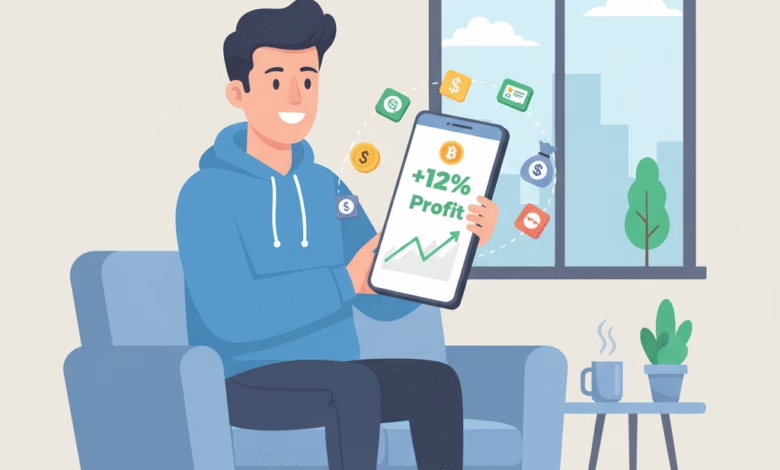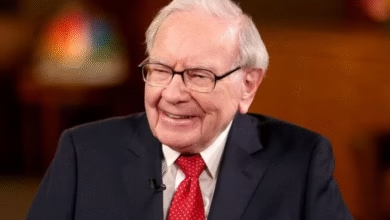10 common mistakes beginners make when investing
Learn about the main mistakes beginners make when entering the financial market

Stepping into the world of investing is one of the most powerful decisions you can make for your financial future. It’s exciting, a little intimidating, and represents a major step toward building real, lasting wealth.
But let’s be honest: the “getting started” part is confusing. The internet is a deafening wall of noise. One person is shouting about a “hot stock,” another is promising riches in crypto, and the news is on a 24/7 loop of economic panic and euphoria.
Who do you listen to? How do you even begin?
Here’s the secret the “gurus” don’t want you to know: Successful investing isn’t about picking the next Apple or Amazon. It’s not about genius, luck, or some complex algorithm.
For most of us, building wealth is simply about consistency and avoiding critical mistakes.
The path to financial independence is paved with the “boring” habits of saving regularly, staying disciplined, and—most importantly—not falling into the same traps that have cost beginners a fortune. This article is your guide to those traps. By understanding these 10 common mistakes, you can sidestep them entirely and start your journey on the right foot.
1. Why Am I Investing? (The Critical Mistake of Not Having a Plan)

This is the most common and most damaging mistake of all. You wouldn’t get in your car and just “start driving” without a destination, so why would you do that with your money?
Many beginners jump in because they feel they “should” or because a friend is doing it (FOMO). They have no goal, which means they have no way to measure success, no framework for making decisions, and no idea what to invest in.
Why This Is a Mistake:
Without a “why,” you have no anchor. When the market gets volatile (and it will), you’ll have no reason to stay the course. You’ll be tempted to buy a risky stock you don’t understand or panic-sell at the first sign of trouble.
How to Fix It:
Before you invest a single dollar, write down your goals. Be specific. Your goals will define your entire strategy:
- Goal: Retirement in 40 years.
- Strategy: You have a long time horizon, so you can take on more risk for more potential growth. A 100% stock-based portfolio (like in an S&P 500 index fund) might be appropriate.
- Goal: A down payment for a house in 3-5 years.
- Strategy: This is a short-term goal. You cannot risk this money in the stock market. A 20% drop could ruin your plans. This money belongs in a “safe” place, like a High-Yield Savings Account (HYSA) or a Certificate of Deposit (CD).
- Goal: Your child’s college education in 15 years.
- Strategy: This is a medium-term goal. Your strategy might be a “hybrid” approach, like a 529 plan that starts aggressive (more stocks) and gets more conservative (more bonds) as your child gets closer to college age.
Your plan is your map. Don’t leave home without it.
2. How an Emergency Fund Protects Your Investments (The Peril of Investing Too Soon)
You have $1,000 saved, and you’re eager to start. You put it all into an index fund. Six weeks later, your car’s transmission fails, and the repair bill is $1,200.
What do you do?
You have no choice. You must sell your $1,000 investment to help cover the repair. The problem? The market had a bad week, and your $1,000 is now only worth $920. You are forced to sell, “locking in” an $80 loss and paying a repair bill.
Why This Is a Mistake:
This is the cardinal sin of “robbing Peter to pay Paul.” Your investments are for the long term. Your savings are for the short term. If you don’t have savings, your long-term investments will be cannibalized by your short-term life.
How to Fix It:
Follow the “Financial Order of Operations.”
- Pay off high-interest debt: Before you invest, destroy any debt with an interest rate over 8-10% (like credit cards). You cannot out-invest a 22% APR.
- Build your emergency fund: Save 3 to 6 months of essential living expenses. This is your “financial fortress.” It’s the wall that protects your investments from life’s surprises. This money does not get invested. It sits in a boring, safe, liquid High-Yield Savings Account (HYSA).
Only after you have this foundation should you begin investing your “surplus” money.
3. What Is Compound Interest? (Why Waiting to Invest Is Your Biggest Risk)
“I’ll start investing when I have more money.”
“I’ll start when I’m older and have a ‘real’ career.”
“I need to research for a few years first.”
These are the most expensive phrases in personal finance. The single most powerful tool in your arsenal is time. And every day you wait, you are giving up your greatest advantage.
The reason is compound interest. Albert Einstein called it the “eighth wonder of the world.” It’s the “snowball effect”—your money earns interest, and then your interest earns interest on itself.
Why This Is a Mistake:
Let’s use a famous example:
- Smart Sarah: Starts investing $300 a month at age 25. She does this for only 10 years, until age 35. She has invested a total of $36,000. She never invests another dime and lets her money grow.
- Waiting William: Starts investing at age 35. He also invests $300 a month, but he does it for 30 years, until age 65. He has invested a total of $108,000.
Who has more money at age 65?
Assuming a 7% average annual return:
- Waiting William (who invested $108,000) has: ~$363,000
- Smart Sarah (who only invested $36,000) has: ~$472,000
Sarah invested one-third of the money but ended up with over $100,000 more. Why? Because her money had 10 extra years to compound.
How to Fix It:
Start now. You don’t need $10,000. You don’t need $1,000. You can open an IRA or brokerage account and buy a low-cost index fund for $50, or even $1. The amount is not as important as the habit.
4. How Diversification Works (The Danger of Being All-In on One Stock)

You get a tip from your cousin who works at Company X. “It’s a sure thing! The new product is a game-changer.” You’re so excited that you put your entire $5,000 of investment money into that one stock.
This is not investing. It’s gambling.
Why This Is a Mistake:
Companies fail. All the time. Even “safe” ones. Remember Enron? WorldCom? These were Wall Street darlings that went to zero, wiping out fortunes. If all your money is tied to the fate of one single company, you are taking on an unthinkably high amount of risk.
How to Fix It:
Diversify. It’s the only “free lunch” in investing. It means “don’t put all your eggs in one basket.”
But you don’t need to buy 50 different stocks. The easiest way for a beginner to diversify is to buy an index fund or ETF (Exchange-Traded Fund).
- Example: By buying one share of an S&P 500 Index Fund, you are instantly buying a tiny piece of all 500 of the largest, most successful companies in America (like Apple, Microsoft, Amazon, Google, etc.).
- If one of those companies has a terrible year, it’s balanced out by the 499 other companies. You have instantly minimized your “single-company risk” while still participating in the growth of the entire market.
5. What Is FOMO in Investing? (The Costly Mistake of Chasing Last Year’s Winners)
In 2021, you heard everyone at Thanksgiving talking about a “meme stock” that went “to the moon.” In 2024, it was an AI chip stock that was up 250%. You see that massive gain and your brain screams, “I need to get in on that!”
This is called FOMO (Fear of Missing Out), and it’s a trap.
Why This Is a Mistake:
By the time a stock is on the cover of a magazine or is the talk of your Thanksgiving table, the easy money has already been made. All the people who got in early are looking for someone to sell their shares to at the new, inflated peak price. That someone is you.
This is called “chasing returns,” and it’s like trying to drive by looking only in the rearview mirror.
How to Fix It:
Have a plan (Mistake #1) and stick to it. Your plan should be to invest consistently (see Mistake #6) in your chosen diversified index funds. The “boring” path is almost always the most profitable. If you want to “play” with a hot stock, use a tiny fraction of your portfolio (1-3%) that you are fully prepared to lose.
6. Can You Successfully ‘Time the Market’? (A Beginner’s Guide to ‘Time in the Market’)
This mistake has two forms:
- Fear: “The market seems way too high right now. I’ll just wait for the next big crash to buy in.”
- Greed: “The market is crashing. I’m going to sell everything and wait to buy back in at the exact bottom.”
Why This Is a Mistake:
Nobody can do this successfully. Not the “experts” on TV, not the most powerful hedge funds, and certainly not a beginner.
Research from J.P. Morgan shows that if you stayed invested in the S&P 500 from 2003 to 2022, your $10,000 would have grown to over $64,000. But if you missed just the 10 best days in the market during that 20-year period (by trying to “time” it), your return would be cut in half, to only $29,000.
How to Fix It:
Embrace the most powerful phrase in finance: “Time in the market beats timing the market.”
The best way to do this is with Dollar-Cost Averaging (DCA). This is an automatic, non-emotional strategy.
- The Plan: You decide to invest $200 every month.
- Month 1: The market is “high.” Your $200 buys 2 shares at $100/each.
- Month 2: The market “crashes.” Your $200 now buys 4 shares at $50/each.
- Month 3: The market is “normal.” Your $200 buys 2.5 shares at $80/each.
- The Result: You have removed all emotion. You automatically bought more shares when the price was low (“on sale”) and fewer shares when the price was high. It’s the perfect beginner strategy.
7. What Should I Do When My Investments Go Down? (The Panic-Selling Trap)

This is the twin of Mistake #6. You’re a new investor. You’ve been diligently investing for a year, and your $5,000 has grown to $5,500. Then, a recession hits. In two months, your account drops to $4,100.
It feels terrible. Your stomach is in knots. You log in every day, watching it fall. You can’t take it anymore, so you sell everything “to stop the bleeding.”
Why This Is a Mistake:
You have just taken a temporary, “on-paper” loss and made it a permanent, real-life loss.
This is the only way to guarantee you lose money in the stock market. Market downturns (called “bear markets” or “corrections”) are a normal, healthy, and unavoidable part of investing. They are the “price of admission” you pay for the high long-term returns.
How to Fix It:
- Have an Emergency Fund (Mistake #2): Knowing you have 6 months of cash on hand means you don’t need this investment money. You can afford to wait.
- Zoom Out: Look at a 100-year chart of the S&P 500. It’s a series of terrifying plunges followed by a relentless, upward-right climb.
- Do Nothing (or Buy More): If your plan is solid, the best response to a market crash is to… do nothing. Or, if you have extra cash, follow your DCA plan (Mistake #6) and buy more while it’s “on sale.”
8. How Investment Fees Are Silently ‘Eating’ Your Returns (The Expense Ratio Trap)
You’re comparing two different index funds. They look identical. But you see one has an “expense ratio” (a fee) of 1.1% and the other has an expense ratio of 0.1%.
“Who cares?” you think. “It’s just 1%.”
That “just 1%” can be the difference between a comfortable retirement and working an extra decade.
Why This Is a Mistake:
That 1% isn’t 1% of your gains. It’s 1% of your entire balance, every single year, whether the market goes up or down.
Let’s Do the Math:
- You invest $20,000 for 30 years. It grows at an average of 7% per year.
- Fund A (The Bad Fund): 1.1% expense ratio.
- Your final balance: ~$122,000
- Fund B (The Good Fund): 0.1% expense ratio.
- Your final balance: ~$162,000
That “tiny” 1% fee ate $40,000 of your money. It’s the biggest silent killer in investing.
How to Fix It:
Become obsessed with fees. When choosing a mutual fund or ETF, the expense ratio is one of the most important numbers. For a simple index fund, you should be paying almost nothing (e.g., 0.05% or less is common).
9. What Is Your ‘Risk Tolerance’? (How to Avoid a Mismatch in Your Portfolio)
This mistake is the cause of panic selling. You take an online quiz that says, “You’re 28 years old, you should be 100% in stocks!” So you do it.
But the quiz didn’t know that you are, by nature, an anxious person who checks your accounts three times a day. The first time the market drops 10%, you have a full-blown meltdown.
Why This Is a Mistake:
Your portfolio is too aggressive for your personal temperament. This mismatch means you will inevitably panic-sell at the worst time.
This also works in reverse. If you’re 28 and so scared of risk that you put all your money in a savings account, you’re not taking enough risk. Your money isn’t growing, and inflation is making you poorer every year. This is called “inflation risk.”
How to Fix It:
Be honest with yourself. This is the “sleep-at-night test.” Your portfolio should be aggressive enough to meet your long-term goals, but conservative enough to let you sleep through a market downturn.
A common starting point is a Target-Date Fund. You pick the fund with the year you plan to retire (e.g., “Target-Date 2060”). It automatically rebalances for you, starting aggressive (more stocks) when you’re young and getting more conservative (more bonds) as you get closer to retirement.
10. How Inflation and Taxes Impact Your Investment Strategy

Beginners often think their “return” is the only number that matters. If they earn 4% in a year, they’re happy.
But they’re forgetting two invisible partners who are taking a cut: Inflation and Taxes.
Why This Is a Mistake:
- Inflation: If your investments earn 4% but inflation (the rising cost of goods) is 3%, your “real return” is only 1%. If your money is in a savings account earning 1% while inflation is 3%, you are losing 2% of your purchasing power every year.
- Taxes: If you invest in a regular brokerage account, you pay “capital gains tax” on your profits when you sell.
How to Fix It:
- Beat Inflation: This is why we invest in the stock market. A savings account is for safety, but it’s a “leaky bucket” that loses to inflation. The stock market, over the long term, has historically beaten inflation by a wide margin.
- Use Tax-Advantaged Accounts: You should always prioritize investing in these “tax-wrapper” accounts before a regular brokerage account.
- 401(k) / 403(b): Your retirement plan at work. At a minimum, contribute enough to get your full employer match (that’s 100% free money).
- IRA (Roth or Traditional): A retirement account you open yourself. A Roth IRA is a beginner’s best friend. You pay taxes now, but all your money grows 100% tax-free forever.
The Easiest Way to Win Is Not to Lose
The path to becoming a successful investor is not a “get rich quick” scheme. It’s a “get rich slow” guarantee.
You don’t have to be a genius. You don’t have to read financial reports. You don’t have to watch the news.
All you have to do is:
- Create a plan.
- Build your emergency fund.
- Start investing today (not tomorrow) in low-cost, diversified index funds.
- Automate your contributions.
- And… that’s it. Go live your life.
By avoiding these 10 simple, common mistakes, you will be miles ahead of 90% of other new investors. The most successful investor isn’t the one with the highest IQ; it’s the one with the most discipline.





